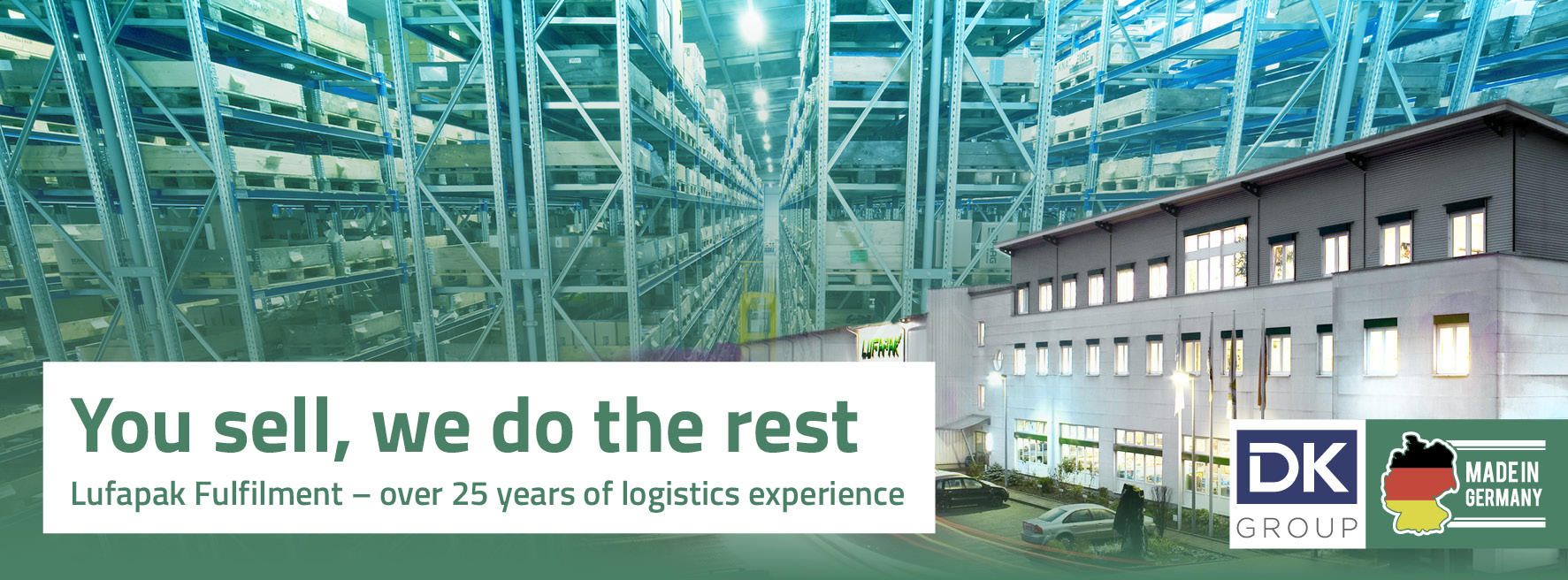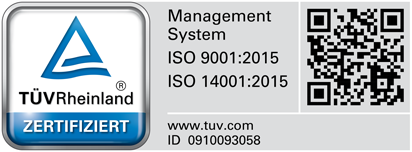sales@lufapak.de +49 2631/384-0 Contactform
Chaotic warehousing (dynamic warehousing)
What is chaotic warehousing? – Definition and basic principles
Chaotic warehousing refers to a flexible storage system in which incoming goods are not assigned fixed storage locations. Products can be stored in any available space, with a digital warehouse management system documenting the exact position of each item. This form of warehouse organisation differs fundamentally from the traditional fixed location system.
In dynamic warehousing, space is allocated at random or according to efficiency criteria. The system automatically selects the optimal storage location based on factors such as route optimisation, weight or turnover frequency. Modern warehouse management systems control all processes from storage to picking.
The terms dynamic or free-space dynamic storage are often used as synonyms for chaotic warehousing. All three terms describe the same principle: the flexible use of existing storage capacity without rigid space allocation.
How does chaotic warehousing work in practice?
The receipt of goods marks the start of the chaotic warehousing process. After delivery, the system records each item with a unique barcode or RFID tag. The goods are automatically assigned an available storage location that best suits their size, weight and turnover rate. The warehouse management system stores all relevant information such as item number, quantity and exact location.
Employees transport the goods to the assigned location and confirm storage using a scanner. The system immediately updates the stock level and space allocation. During subsequent order picking, the software guides warehouse employees to the desired items via optimised routes.

Chaotic storage allows maximum use of space, as every available space can be used. Seasonal fluctuations or different product sizes are no problem. The system adapts flexibly to changing requirements and continuously optimises warehouse processes.
Chaotic warehousing advantages – the most important benefits at a glance
Optimal space utilisation as a key advantage of chaotic warehousing
Efficient use of space is one of the most significant advantages of chaotic warehousing. Flexible space allocation allows storage space to be utilised up to 30 percent better than with fixed location systems. Vacancies due to items that are temporarily out of stock are completely eliminated. Every available square metre is used optimally.
The system takes into account the actual dimensions of the goods and finds suitable gaps in the warehouse. Small items fill niches, while large goods make optimum use of free areas. Intelligent space allocation reduces unused space between shelves to a minimum.
Companies benefit from lower rental costs per stored unit. Improved space efficiency allows more goods to be stored in the same floor space. This significantly reduces storage costs and increases the profitability of the entire logistics operation.
Flexibility and adaptability in chaotic storage
Chaotic storage easily copes with seasonal fluctuations in product ranges. Christmas items or summer goods can be stored spontaneously without the need for restructuring. The system reacts automatically to changes in stock levels and adjusts the allocation of storage space accordingly.
New product lines can be integrated immediately without prior space reservations. The software assigns the best available space to each new item. Product launches or range extensions are therefore smooth and without delays.
The flexible structure is ideal for companies with a changing product range. E-commerce retailers with a wide product range benefit particularly from this adaptability. Even in the event of unpredictable order peaks, the system responds confidently and makes optimum use of free capacity.
Further advantages of dynamic warehousing
Route optimisation significantly reduces picking times. The system calculates the shortest routes and guides employees efficiently through the warehouse. Multi-order picking is possible because the software intelligently bundles multiple orders into rounds. Walking distances are reduced by up to 50 percent compared to conventional methods.
The error rate is significantly reduced thanks to system-supported picking. Scanners and digital displays guide employees precisely to the right product. Mix-ups are virtually eliminated, as each removal must be confirmed electronically. When used correctly, inventory accuracy is close to 100 percent.
Real-time information about stock levels is available at all times. Inventories are greatly simplified because the system provides constantly updated stock data. Transparent warehouse management enables precise ordering and prevents overstocking or bottlenecks.
Chaotic warehousing disadvantages – potential challenges
Technical requirements as disadvantages of chaotic warehousing
Dependence on a functioning IT infrastructure is one of the biggest disadvantages of chaotic warehousing. System failures can paralyse the entire warehouse operation, as items cannot be found without digital support. Redundant systems and regular backups are essential, but incur additional costs.
Implementation requires significant initial investment in hardware and software. Warehouse management systems, scanners, RFID technology and powerful servers add up to considerable expenses. Smaller companies often cannot afford these investments.
System maintenance and updates incur ongoing costs. IT specialists must be able to look after the equipment and respond quickly to any problems. The technical complexity overwhelms some companies, especially if they lack internal expertise.
Other critical aspects of chaotic storage
Employee training proves to be time-consuming and costly. All warehouse staff must be proficient in the use of scanners and software. New employees require thorough training before they can work productively. The change from familiar work processes often leads to resistance at first.
In the event of power failures or network problems, the warehouse comes to a standstill. Manual emergency plans must be in place, but they are only of limited use. Searching for items without system support is like looking for a needle in a haystack. Downtime causes high costs due to delivery delays.
The disadvantages of chaotic warehousing are also evident when it comes to special storage requirements. Temperature-controlled goods or hazardous materials require defined areas despite the chaos principle. The integration of such special zones complicates the system and reduces the advantages of flexibility.
Chaotic warehousing Requirements for successful implementation
Powerful IT systems form the foundation of chaotic warehousing. A stable warehouse management system must be able to control all warehouse processes in real time. The software should be scalable and adaptable to growing requirements. Interfaces to ERP systems and web shops ensure smooth data exchange.
The technical equipment includes mobile data collection devices for all employees. Barcode scanners or RFID readers enable goods and storage locations to be identified quickly. A reliable WLAN network must be available throughout the entire facility. Backup systems protect against data loss.
Qualified personnel and an open corporate culture facilitate the transition. Employees require training in the use of the new technology. The willingness to change must be exemplified by management. Clear process definitions and work instructions create security during the transition phase.
Chaotic warehousing and fixed location system in direct comparison
The main difference between chaotic warehousing and fixed location systems lies in the allocation of space. In a fixed location system, each item is assigned a permanent, predefined storage location. This rigid allocation makes it easy to find items without technical aids. However, empty spaces are created when certain products are out of stock.
Flexibility is what fundamentally distinguishes the two systems. Chaotic systems adapt dynamically to changes in inventory, while fixed location systems react inflexibly. Seasonal goods or new products can be stored immediately in a chaotic warehouse. Fixed location systems require time-consuming replanning when the product range changes.
Hybrid forms combine the advantages of both approaches. Fast-moving items are given fixed locations in favourable positions, while slow-moving items are stored chaotically. ABC analyses help to decide which products benefit from fixed locations. These hybrid solutions are particularly suitable for medium-sized companies with a heterogeneous product range.
Storage systems chaotic warehouse – Technical equipment and software
Modern chaotic warehouse systems are based on sophisticated warehouse management systems. These software solutions coordinate all warehouse processes from receipt to dispatch. Functions such as inventory management, picking and inventory are fully integrated. The systems automatically optimise walking routes and create efficient pick lists.
The hardware components include mobile terminals with barcode scanners. Employees receive work orders directly on their handheld devices. The scanners record items and storage locations in a matter of seconds. Modern devices feature touchscreens and intuitive user interfaces. RFID technology enables contactless recording of entire pallets.
Automation solutions expand the possibilities of chaotic warehouse systems. Shelf servicing devices and driverless transport systems take over the physical transport of goods. Pick-by-light or pick-by-voice systems support manual picking. The integration of robotics and artificial intelligence opens up new optimisation potential.
Conclusion: Who is dynamic warehousing suitable for?
Online retailers with extensive product portfolios benefit particularly from dynamic warehousing. The high variety of items and fluctuating demand require maximum flexibility. Mail order companies can significantly speed up their processes with chaotic systems. Scalability optimally supports the typical growth in e-commerce.
Logistics service providers and contract logistics companies are increasingly relying on chaotic warehouse systems. The flexible allocation of space simplifies the management of different customer inventories. Multi-user concepts can be implemented efficiently. Transparent inventory management enables precise billing and reporting.
Medium-sized manufacturing companies should carefully weigh up the costs and benefits. For stable product ranges with few items, the disadvantages often outweigh the advantages. Hybrid solutions offer a good compromise between flexibility and manageability. The size of the company and its IT expertise are key factors in the success of an implementation.
Contact us now and get advice

